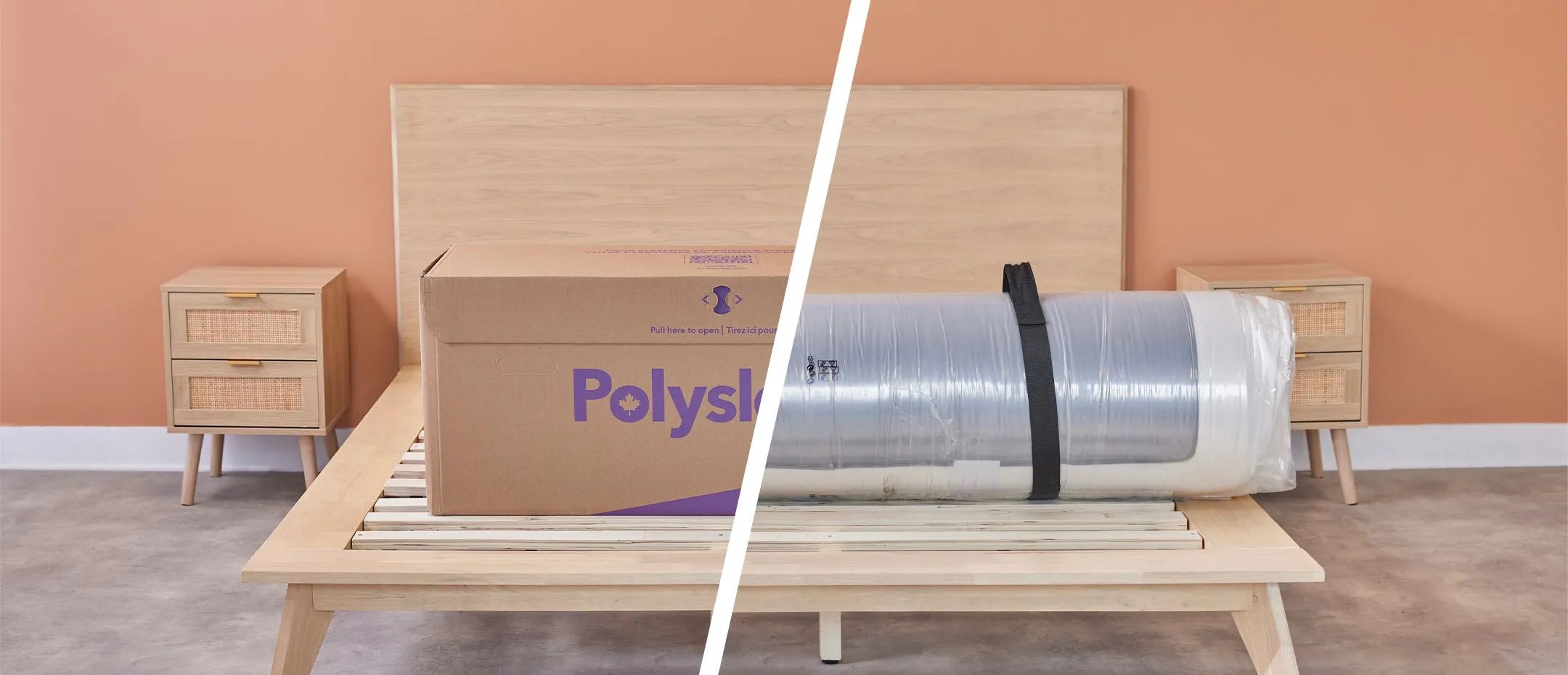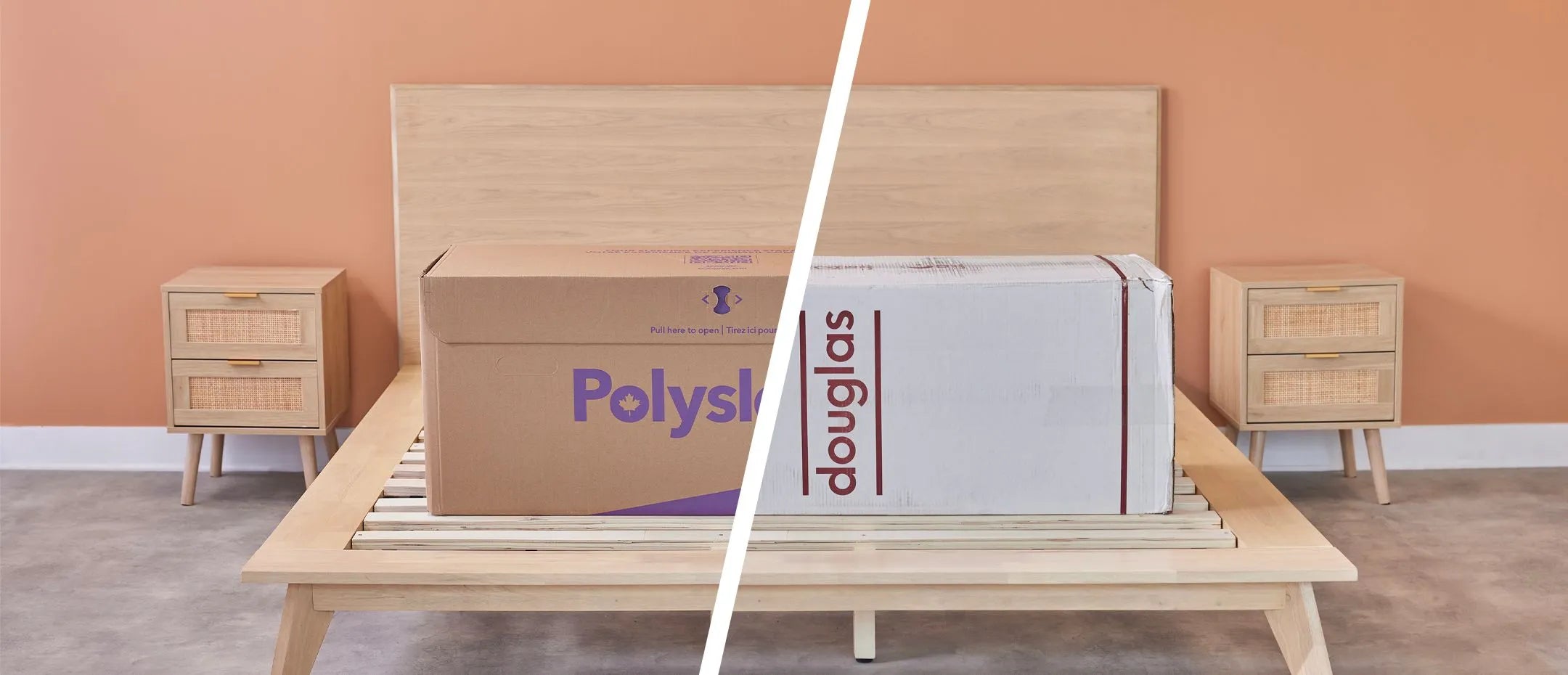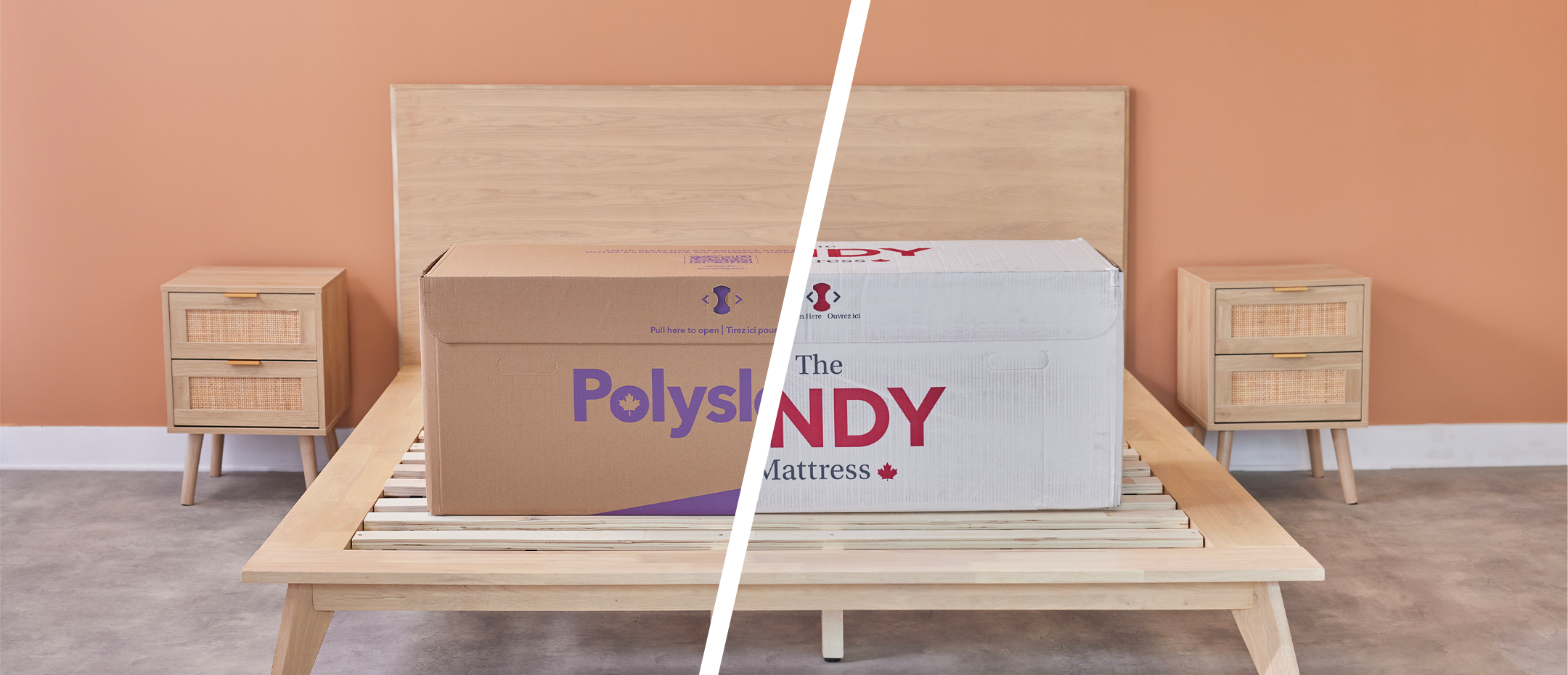Your mattress is getting up there in years and you’re wondering if you should choose a coil or a foam mattress? The latter are breezing ahead in the market, and not without reason. Whether made from latex, simple foam, or ventilated viscoelastic hybrid foam, these types of mattresses offer several advantages over spring mattresses: let’s take a closer look at them together!
How is a spring mattress made?

This type of mattress is the most familiar in the minds of sleepers and for a good reason: this sort of mattress is very old, having been introduced in the 19th century. It’s also, from the early days of industrialization until now, the most common mattress found in North America, including Canada. In terms of structure, all spring mattresses have a base, springs (which provide support) and one or more layers of comfort, which can be made of foam and/or specific fillings. As for the springs, they can be of different coil gauges ranging from 12 to 16, with the rule that the higher the value, the thinner the spring will be. However, the main difference between one spring mattress and another is primarily related to the types of spring. These are detailed below.
Bonnell Springs
The very first type of spring mounted in a spring bed, the Bonnell coil has an hourglass shape to help support your body while you sleep. The gauge of the coil will be the variable to watch for to determine the firmness of your mattress.
Offset Coils
These springs are an offshoot of the Bonnells, with the difference that the wire at the top has been flattened; this allows a mattress with offset coils to better fit the body of the sleeper during the night. They can offer variable geometry comfort, providing more softness at the top, while having firmer support at the base.
Continuous Coil
As the name suggests, a continuous coil system consists of one single piece of wire twisted into rows, which is then connected with helical lacing to provide more firmness.
Pocket springs
Here again, the name says it all: these springs are individually encased in a piece of fabric to reduce noise when you move, while allowing each spring to be effective in its role without disturbing neighbouring springs. This technology has the advantage of reducing the transfer of movement during the night. So, if you have to get up, your better half won't notice!
Advantages of spring mattresses

On average, a Queen mattress will contain about 800 springs. However, it’s neither the number of springs nor their type that should determine the choice of one model over another. Rather, consider their quality level and coil gauge, as well as the other materials that provide support. And most importantly: try it out!
That being said, there are some general advantages to spring mattresses:
-
Although manufactured in countless sizes and various levels of quality, they’re usually less expensive than premium foam mattresses, such as gel or latex.
-
They’re also highly recommended for sleepers who move around a lot during the night.
-
They’ve been on the market for a long time. In this sense, you already know the product, and you know what to expect: even if new technologies appear regularly, the basics remain the same!
-
They’re very durable because they’re built to provide the same level of comfort and support over time. Their life expectancy is on average 10 years. Some rare models can even be good for up to 20 years!
-
In the case of pocket-spring mattresses, you’ll benefit from a very good sleeping independence, while better distribution of pressure points.
-
They offer excellent air circulation, which is perfect if you get too warm at night.
Disadvantages of spring mattresses
For all that, spring mattresses are not perfect and have disadvantages:
-
In the case of continuous coil mattresses, if your bed partner moves, you’ll feel it. Therefore, if you want true sleeping independence, avoid them.
-
They’re heavy, which makes their installation and maintenance more difficult if you want to air them or wash them outside.
-
If the mattress layers are made of wool or fibers, they can quickly become a breeding ground for allergens such as dust mites.
-
Because of that, if you want to keep your spring mattress clean and avoid allergies, you’ll need to wash it more frequently.
The structure of foam mattresses

Usually, a foam mattress has a layered construction.
There are four types of layers:
-
The base layer: this is the layer on which all other layers are stacked, and hence serves as the foundation for the bed structure. On high quality mattresses (like the Polysleep mattress!), it’s made of high-density foam. It helps your mattress keep its shape over time and is in contact with the base of the bed. It also balances your mattress to offer optimal support over time.
-
The support layers: these also help reinforce the mattress as a whole and prevent it from sagging, while providing you with the best possible support.
-
The comfort layers: placed directly on top of the previous type of layer, they’re of course made of foam. These layers identify and relieve your pressure points, offering the desired comfort, while absorbing noise and movement.
-
Finally, the cover. In direct contact with the sheets that will cover your bed, it encapsulates all the above-mentioned foam layers, while protecting them from bacteria, humidity and dirt. The cover prolongs the life of your foam mattress, while giving it a neat and inviting look.
So here is, in broad outline, the structure of foam mattresses. However, there’s more than one category. In fact, we can distinguish four types, depending on the type of foam they’re made of.
Polyether foam mattresses: cheap, but not very durable.
These types of foam mattresses are made, as the name implies, with polyether foam. The main advantage of polyether foam is that it provides the sleeper with a firm sleeping surface. This foam structure is organized in small, closed cells. It’s also a lower density foam.
Because of these characteristics, beds made from polyether foam have the advantages of being:
-
More suitable if you have an unusual build.
-
The most affordable among foam beds.
However, the strengths of this type of bed are quickly overshadowed by the disadvantages:
-
This type of foam is not very resistant to humidity.
-
For those who like soft beds, their comfort could be qualified as basic.
-
Due to the closed structure of the foam, this type of mattress encapsulates heat, which will make you feel hot and sweaty.
-
Because of their lower foam density, this type of mattress is much less durable than the other types presented below, while offering less support.
They’re hence generally low-end foam beds. Polysleep recommends you limit their use for example in children’s bedroom or at the cottage.
Polyurethane foam mattresses: the best price-performance-durability ratio.
Polyurethane foam mattresses feature a significant advantage over their polyether counterparts: they’re made of high-density to very high-density foam, which makes it more resistant to the ravages of time. This higher density also allows for superior support. These foams also generally have antibacterial and antifungal properties and are hypoallergenic.
These same mattresses are also available in a wide variety of foam densities, offering a large selection in terms of type of support and comfort. Since the foam is also open-cell, air circulation is optimized.
Polyurethane foam is, for foam mattresses, the most advantageous because:
-
It offers optimal support-comfort ratio that lasts over time.
-
It gives exceptional longevity to mattresses that contain
-
With the different densities offered, it allows you to find the support that best suits your needs and particularities as a sleeper.
-
It strongly limits the development of allergens through its properties, exposed above.
-
Considering all the positive points, the price is not so high.
-
It can ensure better indoor air quality, like the 2nd and 3rd foam layers of the Polysleep mattress, which is Certi-Pur US certified (less than 0.5 parts per million, and also low VOC).
Disadvantages of these mattresses:
-
They’re more expensive than polyether foam mattresses.
-
You’ll keep them for a long time and might get tired of them!
Memory foam mattresses: high-level support and comfort, plus warmth.

The history of memory foam, a type of foam often rightly used as a marketing argument by mattress manufacturers, has an unusual origin, to say the least. Indeed, it’s a foam made for space: NASA first invented it for space travel. This foam has the particularity of reacting to the heat and pressure of any object that comes into contact with it. This is where the applications for mattresses are all found: memory foam can be adapted to all sleeper profiles in terms of support and comfort!
For all that, it’s usually a type of foam that tends to store heat when the mattress is not equipped with cooling gel. On the other hand, it can only provide maximum support and comfort if it’s in contact with warmth and subjected to a certain pressure.
Given these characteristics, memory foam mattresses offer the following advantages:
-
They provide a personalized support-comfort ratio, very precise to the sleeper, regardless of their morphology or si The memory foam will perfectly shape itself to your body and cancel pressure points.
-
Like polyurethane foam mattresses, they’re made of high-density or ultra-high-density foam, which ensures superior longevity.
But they’re affected by the following potential problems:
-
If they do not have thermoregulating gel, they will make you feel very hot and sweaty, especially in summer.
-
These mattresses are among the most expensive on the market.
-
In the winter, knowing that the foam needs to be in contact with a heat source to offer maximum support and comfort, the first few minutes a sleeper is in bed will be like lying on a hard surface.
Latex mattresses: the qualities of memory foam mattresses, without keeping you warm!

Latex mattresses can be considered the veterans among foam mattresses. In fact, the first latex mattresses appeared in the early 20th century, when latex foam became a usable product thanks to the process created by Dunlop. When it comes to a mattress made from natural latex, it’s extracted from the Hevea tree, also commonly called "rubber tree". There are also mattresses made of synthetic latex: the foam is made of latex, but also of polyurethane, the quantity of which varies. Thus, if a mattress is said to be made of "latex", doesn’t mean it’s necessarily made of natural material!
However, when made of 100% Hevea rubber, the latex foam of which mattresses are composed has advanced properties comparable to memory foam. In fact, the support it provides is firm and it naturally hugs the curves of your body instantly, all without smelling like chemicals. It’s also a hypoallergenic material in most cases. Finally, it’s a material that ensures maximum heat dispersion, while being very durable.

The qualities of latex foam offer very advantageous properties to mattresses that contain it:
-
They have an extraordinary longevity: some latex mattresses can still be good after 15years of use.
-
They offer all the advantages of a memory foam mattress in terms of comfort and support, and this immediately. Indeed, latex does not need to be heated to offer its properties.
-
Latex beds solve the biggest disadvantage of memory foam: optimal heat dispersion. Thus, with a latex mattress, no cold sweats in the summer!
-
In the case of natural latex mattresses, no unpleasant odors, the material being natural. It’s also hypoallergenic and eco-friendly since it comes from a renewable source (tree).
However, latex mattresses have disadvantages that should not be overlooked:
-
Some people are purely and simply allergic to latex. In this case, mattresses made of this material are not suitable for them.
-
Latex mattresses are still among the most expensive today. Why give yourself insomnia troubles for a new mattress when it’s supposed to improve your sleep?
And for the little ones: foam or spring mattress for baby?
Spring mattresses are not recommended for cribs: a spring that comes out of its place could cause injury. In addition, these same springs are made of metal, a type of material that creates magnetic fields that can disturb a baby's sleep. That's why other types of mattresses, primarily foam mattresses, are more appropriate.
However, beware of memory foam mattresses, which can be dangerous for babies. Indeed, they can obstruct the airways of your little one. Memory foam is known for its elasticity and according to the American Academy of Pediatrics, “soft” mattresses increase the risk of suffocation if baby sleeps on his or her stomach. Indeed, under Baby's weight, a "pocket" can form at face level, which can prevent your little one from breathing optimally. This is why a baby mattress must absolutely be very firm, which is not possible with a memory foam mattress.
Conclusion: for the best price-durability-performance ratio; polyurethane foam and viscoelastic hybrid foam made in Polysleep!

As we have just seen, in the war between spring mattresses vs. foam mattresses, the latter wins if we eliminate polyether foam mattresses, which are not expensive to buy but not very durable. In fact, foam mattresses, whether they’re made of polyurethane, memory foam or latex, are all at least as durable as their spring-based competitors, while offering a better support-comfort ratio, all with “independent” sleep regardless of the foam considered.
However, with foam mattresses, some are preferable to others. Polyurethane foam mattresses offer a very substantial longevity while providing support and comfort over time. They also allow optimal ventilation to sleep at the right temperature, while usually limiting allergens. Latex mattresses are at least as durable, while being environmentally friendly when they’re made of natural latex, but they’re much more expensive. Memory foam mattresses, on the other hand, offer targeted and personalized support and comfort, but can literally make you feel hot if they don't have a gel to help dissipate heat.
Polysleep mattresses are the perfect illustration of the extraordinary qualities of polyurethane foam. Indeed, they use this type of foam, but also viscoelastic hybrid foam, with properties close to those of memory foam. This hybrid construction using the two types of foam mentioned above allows the Polysleep mattress to ensure an optimal body position in all circumstances and this, with comfort and on the long term. The most beautiful in all this? As mentioned for the polyurethane foam mattress: very soft prices!
So, to the “spring mattress or foam mattress?” question, Polysleep says “mattresses made of composite polyurethane and hybrid viscoelastic foam”!
Browse the Polysleep collection
If you liked our blog article, please don't forget to Share it with your friends by clicking the button below!










